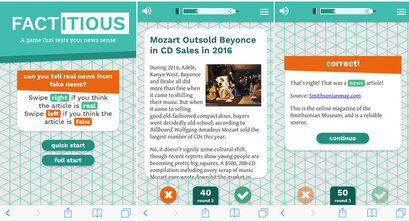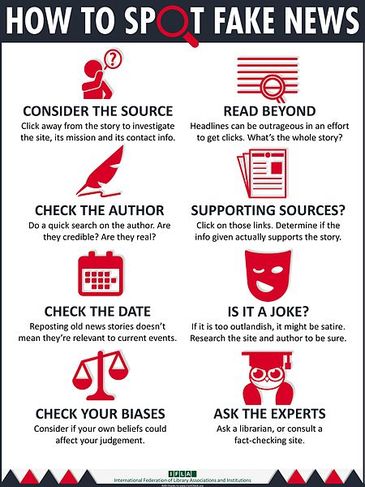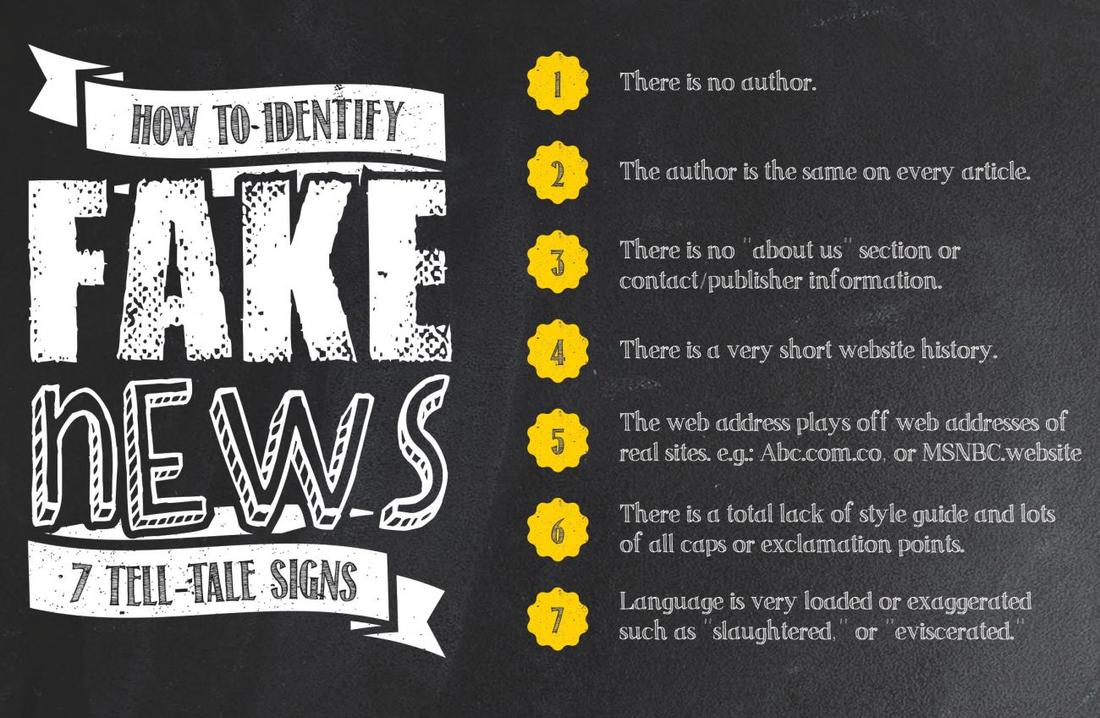Spotting Fake News
www.kaspersky.com/resource-center/preemptive-safety/how-to-identify-fake-news
Highlights from the website are copied below...
How to Identify Fake News
You may be wondering how to identify fake news on Facebook and other social media sites? As a student, how to avoid fake news? Or how to avoid accidentally sharing misinformation online? Here are ten tips to identify misinformation, recognize fake news websites, and think before you share:
1. Check the source:
Check the web address for the page you're looking at. Sometimes, fake news sites may have spelling errors in the URL or use less conventional domain extensions such as ".infonet" or ".offer". If you are unfamiliar with the site, look in the About Us section.
2. Check the author:
Research them to see if they are credible – for example, are they real, do they have a good reputation, are they writing about their specific area of expertise, and do they have a particular agenda? Consider what the writer’s motivation might be.
3. Check other sources:
Are other reputable news or media outlets reporting on the story? Are credible sources cited within the story? Professional global news agencies have editorial guidelines and extensive resources for fact-checking, so if they are also reporting the story, that’s a good sign.
4. Maintain a critical mindset:
A lot of fake news is cleverly written to provoke strong emotional reactions such as fear or anger. Maintain a critical mindset by asking yourself – why has this story been written? Is it promoting a particular cause or agenda? Is it trying to make me click through to another website?
5. Check the facts:
Credible news stories will include plenty of facts – data, statistics, quotes from experts, and so on. If these are missing, question why. Reports with false information often contain incorrect dates or altered timelines, so it’s a good idea to check when the article was published. Is it a current or old news story?
6. Check the comments:
Even if the article or video is legitimate, the comments below may not be. Often links or comments posted in response to content can be autogenerated by bots or people hired to put our misleading or confusing information.
7. Check your own biases:
We all have biases – could these be influencing the way you respond to the article? Social media can create echo chambers by suggesting stories that match your existing browsing habits, interests, and opinions. The more we read from diverse sources and perspectives, the more likely it is that we can draw accurate conclusions.
8. Check whether it’s a joke:
Satirical websites are popular, and sometimes it is not always clear whether a story is just a joke or parody. Check the website to see if it’s known for satire or creating funny stories.
9. Check images are authentic:
Images you see on social media could have been edited or manipulated. Possible signs include warping – where straight lines in the background now appear wavy – as well as strange shadows, jagged edges, or skin tone that looks too perfect. Bear in mind, too, that an image may be accurate but simply used in a misleading context. You can use tools such as Google’s Reverse Image Search to check where an image originates from and whether it has been altered.
10. Use a fact-checking site:
Some of the best known include: Fake news relies on believers reposting, retweeting, or otherwise sharing false information. If you're not sure whether an article is authentic or not, pause and think before you share. To help stay safe online, use an antivirus solution like Kaspersky Total Security, which protects you from hackers, viruses, malware, and other online threats.
Highlights from the website are copied below...
How to Identify Fake News
You may be wondering how to identify fake news on Facebook and other social media sites? As a student, how to avoid fake news? Or how to avoid accidentally sharing misinformation online? Here are ten tips to identify misinformation, recognize fake news websites, and think before you share:
1. Check the source:
Check the web address for the page you're looking at. Sometimes, fake news sites may have spelling errors in the URL or use less conventional domain extensions such as ".infonet" or ".offer". If you are unfamiliar with the site, look in the About Us section.
2. Check the author:
Research them to see if they are credible – for example, are they real, do they have a good reputation, are they writing about their specific area of expertise, and do they have a particular agenda? Consider what the writer’s motivation might be.
3. Check other sources:
Are other reputable news or media outlets reporting on the story? Are credible sources cited within the story? Professional global news agencies have editorial guidelines and extensive resources for fact-checking, so if they are also reporting the story, that’s a good sign.
4. Maintain a critical mindset:
A lot of fake news is cleverly written to provoke strong emotional reactions such as fear or anger. Maintain a critical mindset by asking yourself – why has this story been written? Is it promoting a particular cause or agenda? Is it trying to make me click through to another website?
5. Check the facts:
Credible news stories will include plenty of facts – data, statistics, quotes from experts, and so on. If these are missing, question why. Reports with false information often contain incorrect dates or altered timelines, so it’s a good idea to check when the article was published. Is it a current or old news story?
6. Check the comments:
Even if the article or video is legitimate, the comments below may not be. Often links or comments posted in response to content can be autogenerated by bots or people hired to put our misleading or confusing information.
7. Check your own biases:
We all have biases – could these be influencing the way you respond to the article? Social media can create echo chambers by suggesting stories that match your existing browsing habits, interests, and opinions. The more we read from diverse sources and perspectives, the more likely it is that we can draw accurate conclusions.
8. Check whether it’s a joke:
Satirical websites are popular, and sometimes it is not always clear whether a story is just a joke or parody. Check the website to see if it’s known for satire or creating funny stories.
9. Check images are authentic:
Images you see on social media could have been edited or manipulated. Possible signs include warping – where straight lines in the background now appear wavy – as well as strange shadows, jagged edges, or skin tone that looks too perfect. Bear in mind, too, that an image may be accurate but simply used in a misleading context. You can use tools such as Google’s Reverse Image Search to check where an image originates from and whether it has been altered.
10. Use a fact-checking site:
Some of the best known include: Fake news relies on believers reposting, retweeting, or otherwise sharing false information. If you're not sure whether an article is authentic or not, pause and think before you share. To help stay safe online, use an antivirus solution like Kaspersky Total Security, which protects you from hackers, viruses, malware, and other online threats.




